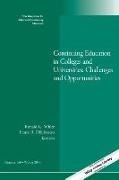Read more
These are times of great opportunity and challenge for continuing education (CE) programs in colleges and universities. While lifelong learning remains central to CE's mission, means of promoting and delivering adult education programs through distance and online learning are undergoing tremendous technological transformation. Within institutions, CE units are increasingly collaborating with academic departments. In addition, demographic shifts have resulted in new audiences and types of programs offered, both credit and noncredit. School are pressured to increase their participation in economic development. All these changes carry administrative considerations. This volume suggests perspective and solutions for the challenges that must be successfully confronted by today's CE programs and the professionals who develop them.This is the 140th volume of this Jossey-Bass series. Noted for its depth of coverage, it explores issues of common interest to instructors, administrators, counselors, and policymakers in a broad range of adult and continuing education settings, such as colleges and universities, extension programs, businesses, libraries, and museums.
List of contents
EDITORS' NOTES 1 Ronald G. White, Frank R. DiSilvestro 1. The Dynamic Flux of Continuing Higher Education: 7 Redefining the New Roles, Responsibilities, and Expectations Lisa R. Braverman The roles and expectations for continuing education programs and professionals are undergoing a period of rapid change. 2. Current Trends in Adult Degree Programs: How Public 17 Universities Respond to the Needs of Adult Learners Angela Gast With pressure to increase the number of adults with degrees, universities are responding with campus-based and online programs and specialized support services. 3. Partnerships with Academic Departments 27 Anthony M. English This chapter offers practical suggestions and examples of successful collaborations between continuing education units and academic departments. 4. From Access to Excess: Changing Roles and Relationships 39 for Distance Education, Continuing Education, and Academic Departments in American Universities Judy Copeland Ashcroft This chapter describes the ways that continuing education units are utilizing distance and online learning in their programs as well as new developments in the use of technology. 5. Growing Importance of Prior Learning Assessment in the 51 Degree-Completion Toolkit Rebecca Klein-Collins, Judith B. Wertheim Although prior learning assessment has been around for several decades, recent developments, including the push to increase the number of adults with college degrees in the United States, have resulted in new developments in assessing learning outside of the classroom. 6. Trends and Considerations Affecting Noncredit Programs 61 Nelson C. Baker This chapter focuses on considerations affecting the development of noncredit programs in a rapidly changing higher education landscape. 7. Role of the Community College in Economic Development 69 Rebecca A. Nickoli This chapter discusses the innovative ways that community colleges are playing an increasing role in local and regional economic development. 8. Continuing Higher Education and Older Adults: A Growing 79 Challenge and Golden Opportunity Frank R. DiSilvestro This chapter focuses on the rapidly aging U.S. population and its impact on the role of continuing higher education. 9. Preparing Marketing for the Future: Strategic Marketing 89 Challenges for Continuing Education James Fong This chapter describes how societal needs and new developments in continuing education are reshaping the role of marketing and program promotion. 10. The Road Ahead: Challenges and Opportunities 101 Ronald G. White This chapter summarizes the major issues and developments addressed in this volume and some of the challenges continuing higher education is likely to face in the coming years. INDEX 107
Summary
These are times of great opportunity and challenge for continuing education (CE) programs in colleges and universities. While lifelong learning remains central to CE's mission, means of promoting and delivering adult education programs through distance and online learning are undergoing tremendous technological transformation.

